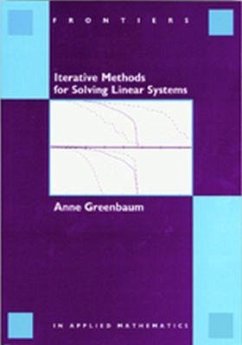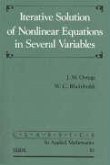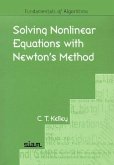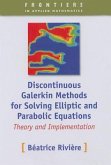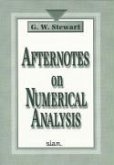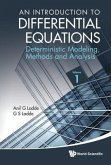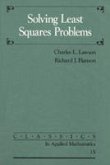Anne Greenbaum
Iterative Methods for Solving Linear Systems
Anne Greenbaum
Iterative Methods for Solving Linear Systems
- Broschiertes Buch
- Merkliste
- Auf die Merkliste
- Bewerten Bewerten
- Teilen
- Produkt teilen
- Produkterinnerung
- Produkterinnerung
Focusing on the analysis of iterative methods, the author includes the most useful algorithms from a practical point of view and discusses the mathematical principles behind their derivation and analysis. Several questions are emphasized throughout: Does the method converge? If so, how fast? Is it optimal, among a certain class? If not, can it be shown to be near-optimal?
Andere Kunden interessierten sich auch für
![Iterative Solution of Nonlinear Equations in Several Variables Iterative Solution of Nonlinear Equations in Several Variables]() J M OrtegaIterative Solution of Nonlinear Equations in Several Variables84,99 €
J M OrtegaIterative Solution of Nonlinear Equations in Several Variables84,99 €![Solving Nonlinear Equations with Newton's Method Solving Nonlinear Equations with Newton's Method]() C T KelleySolving Nonlinear Equations with Newton's Method57,99 €
C T KelleySolving Nonlinear Equations with Newton's Method57,99 €![Discontinuous Galerkin Methods for Solving Elliptic and Parabolic Equations Discontinuous Galerkin Methods for Solving Elliptic and Parabolic Equations]() Béatrice M RivièreDiscontinuous Galerkin Methods for Solving Elliptic and Parabolic Equations86,99 €
Béatrice M RivièreDiscontinuous Galerkin Methods for Solving Elliptic and Parabolic Equations86,99 €![Afternotes on Numerical Analysis Afternotes on Numerical Analysis]() G W StewartAfternotes on Numerical Analysis65,99 €
G W StewartAfternotes on Numerical Analysis65,99 €![Introduction to Differential Equations, An: Deterministic Modeling, Methods and Analysis (Volume 1) Introduction to Differential Equations, An: Deterministic Modeling, Methods and Analysis (Volume 1)]() Anilchandra G LaddeIntroduction to Differential Equations, An: Deterministic Modeling, Methods and Analysis (Volume 1)76,99 €
Anilchandra G LaddeIntroduction to Differential Equations, An: Deterministic Modeling, Methods and Analysis (Volume 1)76,99 €![Solving Least Square Problems Solving Least Square Problems]() Charles L LawsonSolving Least Square Problems65,99 €
Charles L LawsonSolving Least Square Problems65,99 €![Ten Lectures on Wavelets Ten Lectures on Wavelets]() Ingrid DaubechiesTen Lectures on Wavelets93,99 €
Ingrid DaubechiesTen Lectures on Wavelets93,99 €-
-
-
Focusing on the analysis of iterative methods, the author includes the most useful algorithms from a practical point of view and discusses the mathematical principles behind their derivation and analysis. Several questions are emphasized throughout: Does the method converge? If so, how fast? Is it optimal, among a certain class? If not, can it be shown to be near-optimal?
Produktdetails
- Produktdetails
- Verlag: Society for Industrial and Applied Mathematics (SIAM)
- Seitenzahl: 234
- Erscheinungstermin: 1. Januar 1987
- Englisch
- Abmessung: 253mm x 178mm x 13mm
- Gewicht: 422g
- ISBN-13: 9780898713961
- ISBN-10: 089871396X
- Artikelnr.: 23252193
- Herstellerkennzeichnung
- Libri GmbH
- Europaallee 1
- 36244 Bad Hersfeld
- gpsr@libri.de
- Verlag: Society for Industrial and Applied Mathematics (SIAM)
- Seitenzahl: 234
- Erscheinungstermin: 1. Januar 1987
- Englisch
- Abmessung: 253mm x 178mm x 13mm
- Gewicht: 422g
- ISBN-13: 9780898713961
- ISBN-10: 089871396X
- Artikelnr.: 23252193
- Herstellerkennzeichnung
- Libri GmbH
- Europaallee 1
- 36244 Bad Hersfeld
- gpsr@libri.de
1. List of Algorithms
2. Preface
3. Chapter 1: Introduction. Brief Overview of the State of the Art
4. Notation
5. Review of Relevant Linear Algebra
6. Part I: Krylov Subspace Approximations. Chapter 2: Some Iteration Methods.
Simple Iteration
7. Orthomin(1) and Steepest Descent
8. Orthomin(2) and CG
9. Orthodir, MINRES, and GMRES
10. Derivation of MINRES and CG from the Lanczos Algorithm
11. Chapter 3: Error Bounds for CG, MINRES, and GMRES. Hermitian Problems—CG
and MINRES
12. Non-Hermitian Problems—GMRES
13. Chapter 4: Effects of Finite Precision Arithmetic. Some Numerical Examples
14. The Lanczos Algorithm
15. A Hypothetical MINRES/CG Implementation
16. A Matrix Completion Problem
17. Orthogonal Polynomials
18. Chapter 5: BiCG and Related Methods. The Two-Sided Lanczos Algorithm
19. The Biconjugate Gradient Algorithm
20. The Quasi-Minimal Residual Algorithm
21. Relation Between BiCG and QMR
22. The Conjugate Gradient Squared Algorithm
23. The BiCGSTAB Algorithm
24. Which Method Should I Use?
25. Chapter 6: Is There A Short Recurrence for a Near-Optimal Approximation?
The Faber and Manteuffel Result
26. Implications
27. Chapter 7: Miscellaneous Issues. Symmetrizing the Problem
28. Error Estimation and Stopping Criteria
29. Attainable Accuracy
30. Multiple Right-Hand Sides and Block Methods
31. Computer Implementation
32. Part II: Preconditioners. Chapter 8: Overview and Preconditioned
Algorithms. Chapter 9: Two Example Problems. The Diffusion Equation
33. The Transport Equation
34. Chapter 10: Comparison of Preconditioners. Jacobi, Gauss--Seidel, SOR
35. The Perron--Frobenius Theorem
36. Comparison of Regular Splittings
37. Regular Splittings Used with the CG Algorithm
38. Optimal Diagonal and Block Diagonal Preconditioners
39. Chapter 11: Incomplete Decompositions. Incomplete Cholesky Decomposition
40. Modified Incomplete Cholesky Decomposition
41. Chapter 12: Multigrid and Domain Decomposition Methods. Multigrid Methods
42. Basic Ideas of Domain Decomposition Methods.
2. Preface
3. Chapter 1: Introduction. Brief Overview of the State of the Art
4. Notation
5. Review of Relevant Linear Algebra
6. Part I: Krylov Subspace Approximations. Chapter 2: Some Iteration Methods.
Simple Iteration
7. Orthomin(1) and Steepest Descent
8. Orthomin(2) and CG
9. Orthodir, MINRES, and GMRES
10. Derivation of MINRES and CG from the Lanczos Algorithm
11. Chapter 3: Error Bounds for CG, MINRES, and GMRES. Hermitian Problems—CG
and MINRES
12. Non-Hermitian Problems—GMRES
13. Chapter 4: Effects of Finite Precision Arithmetic. Some Numerical Examples
14. The Lanczos Algorithm
15. A Hypothetical MINRES/CG Implementation
16. A Matrix Completion Problem
17. Orthogonal Polynomials
18. Chapter 5: BiCG and Related Methods. The Two-Sided Lanczos Algorithm
19. The Biconjugate Gradient Algorithm
20. The Quasi-Minimal Residual Algorithm
21. Relation Between BiCG and QMR
22. The Conjugate Gradient Squared Algorithm
23. The BiCGSTAB Algorithm
24. Which Method Should I Use?
25. Chapter 6: Is There A Short Recurrence for a Near-Optimal Approximation?
The Faber and Manteuffel Result
26. Implications
27. Chapter 7: Miscellaneous Issues. Symmetrizing the Problem
28. Error Estimation and Stopping Criteria
29. Attainable Accuracy
30. Multiple Right-Hand Sides and Block Methods
31. Computer Implementation
32. Part II: Preconditioners. Chapter 8: Overview and Preconditioned
Algorithms. Chapter 9: Two Example Problems. The Diffusion Equation
33. The Transport Equation
34. Chapter 10: Comparison of Preconditioners. Jacobi, Gauss--Seidel, SOR
35. The Perron--Frobenius Theorem
36. Comparison of Regular Splittings
37. Regular Splittings Used with the CG Algorithm
38. Optimal Diagonal and Block Diagonal Preconditioners
39. Chapter 11: Incomplete Decompositions. Incomplete Cholesky Decomposition
40. Modified Incomplete Cholesky Decomposition
41. Chapter 12: Multigrid and Domain Decomposition Methods. Multigrid Methods
42. Basic Ideas of Domain Decomposition Methods.
1. List of Algorithms
2. Preface
3. Chapter 1: Introduction. Brief Overview of the State of the Art
4. Notation
5. Review of Relevant Linear Algebra
6. Part I: Krylov Subspace Approximations. Chapter 2: Some Iteration Methods.
Simple Iteration
7. Orthomin(1) and Steepest Descent
8. Orthomin(2) and CG
9. Orthodir, MINRES, and GMRES
10. Derivation of MINRES and CG from the Lanczos Algorithm
11. Chapter 3: Error Bounds for CG, MINRES, and GMRES. Hermitian Problems—CG
and MINRES
12. Non-Hermitian Problems—GMRES
13. Chapter 4: Effects of Finite Precision Arithmetic. Some Numerical Examples
14. The Lanczos Algorithm
15. A Hypothetical MINRES/CG Implementation
16. A Matrix Completion Problem
17. Orthogonal Polynomials
18. Chapter 5: BiCG and Related Methods. The Two-Sided Lanczos Algorithm
19. The Biconjugate Gradient Algorithm
20. The Quasi-Minimal Residual Algorithm
21. Relation Between BiCG and QMR
22. The Conjugate Gradient Squared Algorithm
23. The BiCGSTAB Algorithm
24. Which Method Should I Use?
25. Chapter 6: Is There A Short Recurrence for a Near-Optimal Approximation?
The Faber and Manteuffel Result
26. Implications
27. Chapter 7: Miscellaneous Issues. Symmetrizing the Problem
28. Error Estimation and Stopping Criteria
29. Attainable Accuracy
30. Multiple Right-Hand Sides and Block Methods
31. Computer Implementation
32. Part II: Preconditioners. Chapter 8: Overview and Preconditioned
Algorithms. Chapter 9: Two Example Problems. The Diffusion Equation
33. The Transport Equation
34. Chapter 10: Comparison of Preconditioners. Jacobi, Gauss--Seidel, SOR
35. The Perron--Frobenius Theorem
36. Comparison of Regular Splittings
37. Regular Splittings Used with the CG Algorithm
38. Optimal Diagonal and Block Diagonal Preconditioners
39. Chapter 11: Incomplete Decompositions. Incomplete Cholesky Decomposition
40. Modified Incomplete Cholesky Decomposition
41. Chapter 12: Multigrid and Domain Decomposition Methods. Multigrid Methods
42. Basic Ideas of Domain Decomposition Methods.
2. Preface
3. Chapter 1: Introduction. Brief Overview of the State of the Art
4. Notation
5. Review of Relevant Linear Algebra
6. Part I: Krylov Subspace Approximations. Chapter 2: Some Iteration Methods.
Simple Iteration
7. Orthomin(1) and Steepest Descent
8. Orthomin(2) and CG
9. Orthodir, MINRES, and GMRES
10. Derivation of MINRES and CG from the Lanczos Algorithm
11. Chapter 3: Error Bounds for CG, MINRES, and GMRES. Hermitian Problems—CG
and MINRES
12. Non-Hermitian Problems—GMRES
13. Chapter 4: Effects of Finite Precision Arithmetic. Some Numerical Examples
14. The Lanczos Algorithm
15. A Hypothetical MINRES/CG Implementation
16. A Matrix Completion Problem
17. Orthogonal Polynomials
18. Chapter 5: BiCG and Related Methods. The Two-Sided Lanczos Algorithm
19. The Biconjugate Gradient Algorithm
20. The Quasi-Minimal Residual Algorithm
21. Relation Between BiCG and QMR
22. The Conjugate Gradient Squared Algorithm
23. The BiCGSTAB Algorithm
24. Which Method Should I Use?
25. Chapter 6: Is There A Short Recurrence for a Near-Optimal Approximation?
The Faber and Manteuffel Result
26. Implications
27. Chapter 7: Miscellaneous Issues. Symmetrizing the Problem
28. Error Estimation and Stopping Criteria
29. Attainable Accuracy
30. Multiple Right-Hand Sides and Block Methods
31. Computer Implementation
32. Part II: Preconditioners. Chapter 8: Overview and Preconditioned
Algorithms. Chapter 9: Two Example Problems. The Diffusion Equation
33. The Transport Equation
34. Chapter 10: Comparison of Preconditioners. Jacobi, Gauss--Seidel, SOR
35. The Perron--Frobenius Theorem
36. Comparison of Regular Splittings
37. Regular Splittings Used with the CG Algorithm
38. Optimal Diagonal and Block Diagonal Preconditioners
39. Chapter 11: Incomplete Decompositions. Incomplete Cholesky Decomposition
40. Modified Incomplete Cholesky Decomposition
41. Chapter 12: Multigrid and Domain Decomposition Methods. Multigrid Methods
42. Basic Ideas of Domain Decomposition Methods.

